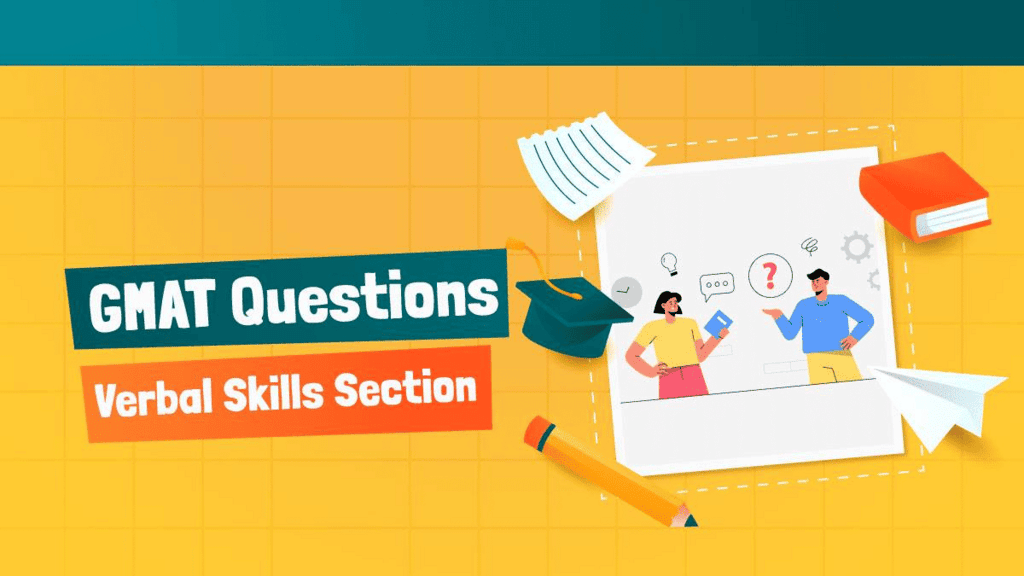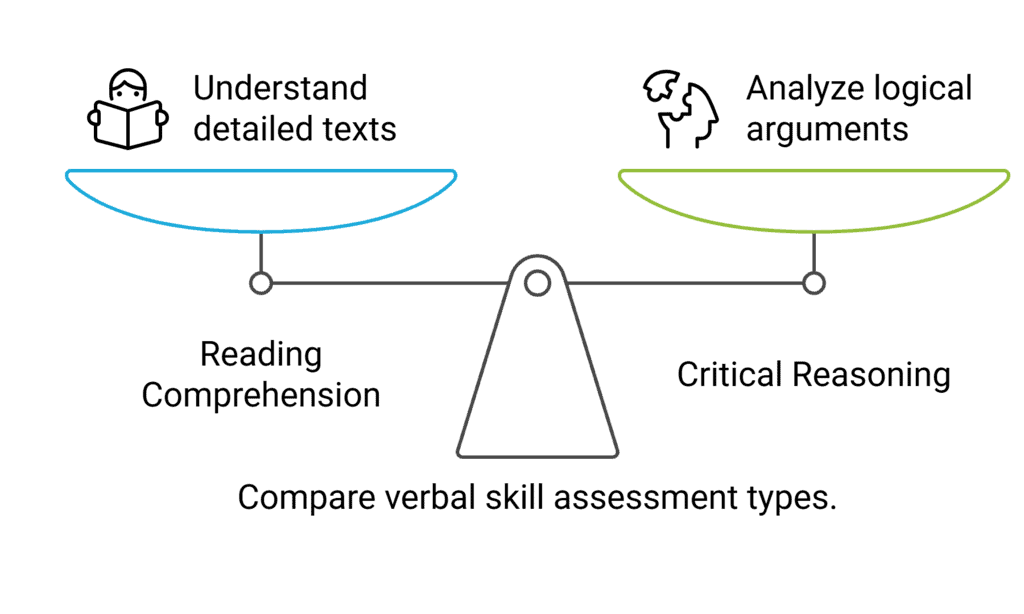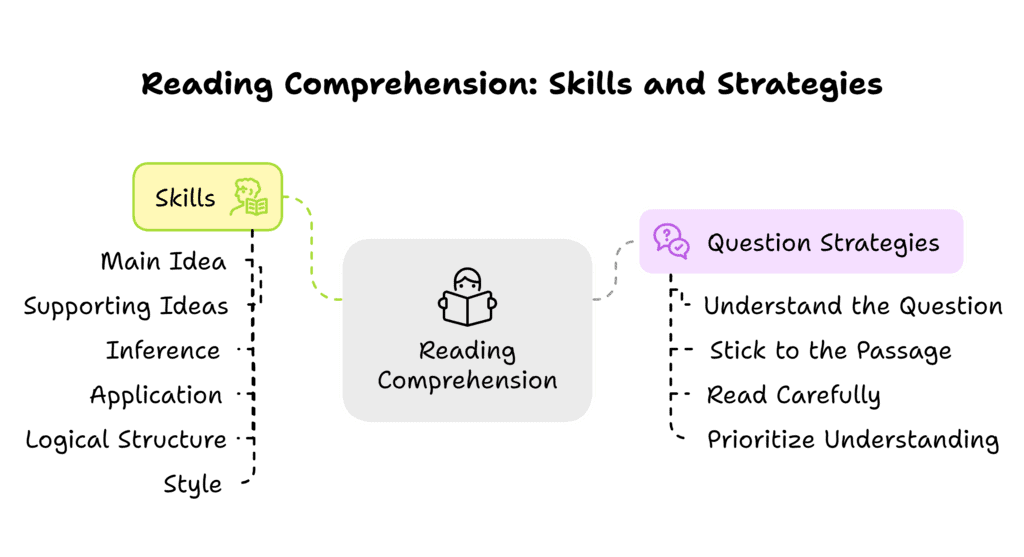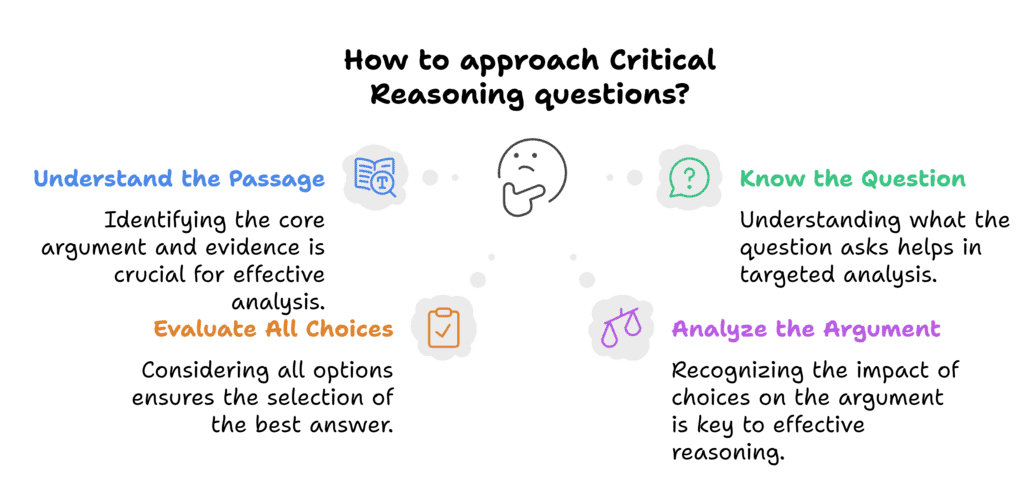Types of Questions- Verbal Reasoning Section GMAT | Verbal for GMAT PDF Download
| Table of contents |

|
| Two Types of Questions in the Verbal Section: |

|
| Reading Comprehension |

|
| Critical Reasoning |

|
| Test Your Verbal Skills: Sample Reading Comprehension Questions |

|
The Verbal Reasoning section of the GMAT measures your ability to read and comprehend written material, reason critically, and evaluate arguments, all in standard written English. This section consists of 23 multiple-choice questions, and you will have 45 minutes to complete it.

Two Types of Questions in the Verbal Section:
There are two types of questions in the Verbal Section:
1. Reading Comprehension
2. Critical Reasoning
Both question types are designed to assess specific verbal skills. You do not need specialized knowledge of the subject matter to answer the questions.

Reading Comprehension
Reading Comprehension tests your ability to understand written material, identify logical relationships between significant points, draw inferences, and follow the development of concepts. Specifically, the following reading skills will be assessed:
Main Idea
Supporting Ideas
Inference
Application
Logical Structure
Style
Each Reading Comprehension passage is followed by questions that require you to interpret material, make inferences, or apply the passage's ideas in a new context. The topics covered may include social sciences, humanities, physical and biological sciences, or business-related fields. You do not need specialized knowledge of the topic to answer the questions.
Reading Comprehension Question Strategies:

Understand the Question: Be sure you know what the question is asking. Even if the answer restates the passage accurately, it can be incorrect if it doesn’t address the specific question.
Stick to the Passage: Answer questions based on what is stated or implied in the passage. Do not let outside knowledge influence your answer.
Read Carefully: Review all answer choices before making your decision.
Prioritize Understanding: Focus on comprehension, not speed. Understanding the passage thoroughly is crucial for success.
Critical Reasoning
Critical Reasoning assesses your ability to make and evaluate arguments, and to formulate or evaluate a plan of action. The questions typically involve short reading passages of fewer than 100 words, followed by a question that asks you to analyze, strengthen, weaken, or identify flaws in an argument.

Critical Reasoning Question Strategies:
Understand the Passage: Identify the core argument, the conclusion, and any supporting evidence or reasoning.
Know What the Question Is Asking: Read the question first to know what to look for in the passage.
Evaluate All Answer Choices: The right answer may not be the obvious one. Consider all options carefully.
Analyze the Argument: Recognize whether the argument is being strengthened, weakened, or challenged by the answer choices.
Test Your Verbal Skills: Sample Reading Comprehension Questions
1. Directions: The questions in this group are based on the content of a passage. After reading the passage, choose the best answer to each question. Answer all questions following the passage on the basis of what is stated or implied in the passage.
Passage:
Schools expect textbooks to be a valuable source of information for students. My research suggests, however, that textbooks that address the place of Native Americans within the history of the United States distort history to suit a particular cultural value system. In some textbooks, for example, settlers are pictured as more humane, complex, skillful, and wise than Native Americans. In essence, textbooks stereotype and depreciate the numerous Native American cultures while reinforcing the attitude that the European conquest of the New World denotes the superiority of European cultures. Although textbooks evaluate Native American architecture, political systems, and homemaking, I contend that they do it from an ethnocentric, European perspective without recognizing that other perspectives are possible.
One argument against my contention asserts that, by nature, textbooks are culturally biased and that I am simply underestimating children's ability to see through these biases. Some researchers even claim that by the time students are in high school, they know they cannot take textbooks literally. Yet substantial evidence exists to the contrary. Two researchers, for example, have conducted studies that suggest that children's attitudes about particular cultures are strongly influenced by the textbooks used in schools. Given this, an ongoing, careful review of how school textbooks depict Native Americans is certainly warranted.
Question:
Which of the following would most logically be the topic of the paragraph immediately following the passage?
(A) Specific ways to evaluate the biases of United States history textbooks.
(B) The centrality of the teacher's role in United States history courses.
(C) Nontraditional methods of teaching United States history.
(D) The contributions of European immigrants to the development of the United States.
(E) Ways in which parents influence children's political attitudes.
Answer: (A)
Explanation:
The passage discusses how textbooks depict Native Americans and the biases involved. The next paragraph would logically continue by providing methods for evaluating such biases to ensure that textbooks present a more accurate and diverse perspective. Option (A) fits this continuation, while other options don't directly address the focus on textbook evaluation.
2. Directions: Answer the questions after reading through the passage. Base your answers on information that is either stated or implied in the passage then click to see the answers.
Passage:
Prior to the nineteenth century, both human and animal populations were limited by the finite resources (such as food) to which they had access. When the enormous increases in prosperity ushered in by the Industrial Revolution essentially freed many Western nations from these constraints, scientists of the time expected Malthusian explosion in population. However, an inverse relationship between prosperity and reproduction was soon noted; the average size of families fell. The trend continues to this day and has spread to recently industrialized portions of the world.
Early biologists tried to explain the transition to smaller families by drawing comparisons to the animal world. Animals that have many young tend to live in hostile, unpredictable environments. Since the odds against any given offspring's survival are high, having many offspring increases the chance that at least one or two of them will survive. In contrast, animals that have fewer children but invest more resources in child rearing tend to live in stable, less hostile environments. While the young of these “high-investment” species enjoy the benefits of a relatively safe environment, they need to compete with animals whose young are equally unlikely to perish early in life. Therefore, the biologists observed, progeny that have acquired the skills they need to compete while sheltered by a family have an advantage over their less prepared competitors. By analogy, if people living in a prosperous environment produced only a few, pampered children, those children would outcompete the progeny of parents who had stretched their resources too widely.
Critics of this theory argue that there are limitations in conflating animal and human behavior. They argue instead that changes in social attitudes are adequate to explain this phenomenon. To a family in a society that is tied to the land, a large number of children is a great boon. They increase family income by being put to work early, and usually some can be persuaded to care for their parents into old age. As a society becomes richer, and as physical labor becomes less important, education may extend into the early twenties, making children economically unattractive as they now consume family assets rather than produce them. Meanwhile, plans such as pensions and Social Security mitigate the need for children to care for their parents into their dotage.
Q1: The primary purpose of the passage is to
A. Criticize explanations of human behavior that are based solely on observations taken from the animal world.
B. Show why the expected population explosion following the Industrial Revolution did not occur before the Industrial Revolution.
C. Demonstrate how family size was influenced by both environmental restraints and social attitudes before and after the Industrial Revolution.
D. Present two alternative theories that explain why family size tends to shrink with increased prosperity.
E. Argues that studies based on social attitudes are more effective than models based on evolutionary advantages in accounting for demographic patterns.
Answer: (D)
Explanation:
The passage presents two views: one based on biological theory (animal behavior) and the other on social attitudes. The primary purpose is to contrast these explanations.
Q2: According to the passage, which of the following is true of a Malthusian explosion on population ?
A. It's occurrence has been limited to those areas of the globe that have remained pre-industrial.
B. It is inevitable in societies making the transition from an economy based on agriculture to one based on industry.
C. It was predicted by at least some who lived through the Industrial Revolution in the West.
D. Social scientists have only recently reached consensus on the question of why it fails to occur in recently industrialized countries.
E. It was avoided in Western society because wealth created by industrialization allowed families to support children through extended periods of education.
Answer: (C) It was predicted by at least some who lived through the Industrial Revolution in the West.
Explanation:
The passage refers to the expectation of a population explosion due to increased prosperity in Western nations during the Industrial Revolution, indicating that this was predicted by some contemporaries.
Q3: The last paragraph performs which of the following functions in the passage?
A. It presents an alternative explanation for the phenomenon described in the first paragraph.
B. It criticizes the explanation presented in the second paragraph.
C. It describes how social attitudes change as societies become richer.
D. It explains a phenomenon presented in the second paragraph.
E. It argues that changing social attitude are sufficient to explain the phenomenon described in the first paragraph.
Answer: (A) It presents an alternative explanation for the phenomenon described in the first paragraph.
Explanation:
The last paragraph discusses critics' arguments, presenting an alternative explanation for the shrinking family size, which contrasts with the earlier biological theory.
Q4: The passage mentions each of the following as a possible reason average family size might fall in recently industrialized nations EXCEPT:
A. Extended periods of education that make children a drain on family resources
B. Well-fed, advantaged children who out-compete those in less advantaged families
C. Improved social care of the elderly
D. Changed social attitudes
E. Increased demand for physical laborers in recently industrialized economies
Answer: (E) Increased demand for physical laborers in recently industrialized economies.
Explanation:
The passage does not mention an increased demand for physical laborers as a reason for smaller family sizes in industrialized economies. Instead, it focuses on education and social care.
Q5: The information in the passage suggests that which of the following animals would be most likely to have many young?
A. A giant plant eater that lives in drought-susceptible grassland and is fiercely protective of its offspring.
B. An omnivore whose population is restricted to several small islands that are threatened by human encroachment.
C. A meat eater that has no natural predators but must migrate long distances to maintain its supply of food.
D. A scavenger that competes with few other species for territory and food.
E. A filter feeder that is prey for many creatures in the seasonal streams and lakes where it lives.
Answer: (E) A filter feeder that is prey for many creatures in the seasonal streams and lakes where it lives.
Explanation:
Animals that are prey for many creatures, like filter feeders, tend to produce many offspring to increase the chance of survival, as described in the passage.
Q6: The author mentions a decrease in the importance of physical labor (line 28) in order to
A. Give an example of the factors that may lead to changes in social attitudes toward family size.
B. Demonstrate why those who anticipated a Malthusian explosion in population in the industrialized Europe where incorrect.
C. Show how family structures adjust to meet the demands of a changing economy.
D. Rebut the claims of those who argue that there are limitations in conflating human and animal behavior.
E. Illustrate how larger families can increase family income.
Answer: (A) Give an example of the factors that may lead to changes in social attitudes toward family size.
Explanation:
The author uses the decrease in physical labor to show how changes in social attitudes contribute to smaller family sizes as economies become wealthier.
Sample Critical Reasoning Question:
Directions: For this question, select the best of the answer choices given.
Question: The cost of producing radios in Country Q is ten percent less than the cost of producing radios in Country Y. Even after transportation fees and tariff charges are added, it is still cheaper for a company to import radios from Country Q to Country Y than to produce radios in Country Y.
The statements above, if true, best support which of the following assertions?
(A) Labor costs in Country Q are ten percent below those in Country Y.
(B) Importing radios from Country Q to Country Y will eliminate ten percent of the manufacturing jobs in Country Y.
(C) The tariff on a radio imported from Country Q to Country Y is less than ten percent of the cost of manufacturing the radio in Country Y.
(D) The fee for transporting a radio from Country Q to Country Y is more than ten percent of the cost of manufacturing the radio in Country Q.
(E) It takes ten percent less time to manufacture a radio in Country Q than it does in Country Y.
Ans: (C)
Explanation:
If importing radios from Country Q is cheaper than manufacturing them in Country Y even after adding transportation and tariff fees, the tariff must account for less than 10% of the manufacturing cost, as this is the remaining factor that makes importing cheaper.
Q1: Artistic success as an actor is directly dependent on how well an actor has developed his craft. This has been demonstrated by the discovery of a positive relationship between the number of classes taken by an actor and the number of professional productions in which the actor has appeared in the past two years.
Each of the following, if true, cast doubt on the author's argument about artistic success for actors EXCEPT:
A. The figures for the number of classes taken were based solely on information provided by actors.
B. Success as an actor cannot necessarily be judged exclusively by recent credits.
C. For most successful actors, it's not the quantity but the quality of their classes that has helped to develop their craft.
D. There is no relationship between the number of professional productions in which an actor has appeared and true artistic success.
E. Most successful actors have taken only a small number of intensive classes.
Answer: (A) The figures for the number of classes taken were based solely on information provided by actors.
Explanation:
Option (A) is the only statement that does not cast doubt on the argument. The other options raise concerns about the accuracy and relevance of the relationship between classes taken and success.
Q2: Music Industry executives have claimed that online file-sharing networks are significantly hurting their business because potential consumers are getting music for free that they would otherwise purchase. However, after file-sharing networks started to become popular, CD sales actually increased.
Which of the following, if true, best explains the apparent contradictions described above ?
A. File-sharing networks carry a more complete variety of music than most traditional music stories.
B. The few people using file-sharing networks already purchased more music than most people.
C. Many people prefer to store their music as computer files rather than maintain large CD collections.
D. Many consumers have purchased music by artists they discovered through file-sharing networks.
E. Music available on file-sharing networks is on the same audio quality as music on commercially produced CDs.
Answer: (D) Many consumers have purchased music by artists they discovered through file-sharing networks.
Explanation:
This explanation suggests that while file-sharing networks provide free access to music, they also help consumers discover new artists, leading to increased CD sales.
Q3: Parents of high school students argue that poor attendance is the result of poor motivation. If students' attitudes improve, regular attendance will result. The administration, they believe, should concentrate less on making stricter attendance policies and more increasing students' learning.
Which of the following, if true, would most effectively weaken the parents' argument?
A. Motivation to learn can be improved at home, during time spent with parents.
B. The degree of interest in learning that a student develops is a direct result of the amount of time he or she spends in the classroom.
C. Showing a student how to be motivated is insufficient; the students must also accept responsibility for his or her decisions.
D. Unmotivated students do not perform as well in school as other students.
Answer: (B) The degree of interest in learning that a student develops is a direct result of the amount of time he or she spends in the classroom.
Explanation:
If student interest in learning is closely tied to classroom time, then improving attendance (spending more time in class) would directly improve motivation, weakening the parents' argument.
Q4: A study of children's television-watching habits by the federal Department of Education found that children aged 7-10 who watched more than 25 hours of television per week performed worse in school than children of the same age who watched fewer than 25 hours of television per week. Therefore, parents of children aged 7-10 should prohibit their children from watching more than 25 hours of television per week.
Which of the following, if true, would be best to strengthen the argument above?
A. A separate study, by a renowned graduate school education, found that when a separate prohibited their children from watching any television, the children's reading scores increase rapidly and significantly and stayed high indefinitely.
B. Children who watched more than 25 hours of television per week also performed worse on measures of physical fitness than children who watched fewer than 25 hours per week.
C. The television shows that children aged 7-10 are most likely to watch are saturated with advertisements for products, such as toys and candy, of little educational value.
D. The Department of Education study gave appropriate weight to children of backgrounds representative of children nationwide.
Answer: (D) The Department of Education study gave appropriate weight to children of backgrounds representative of children nationwide.
Explanation:
This ensures that the study's findings are applicable to the general population, strengthening the argument that limiting television time could improve school performance.
|
31 videos|51 docs|35 tests
|
FAQs on Types of Questions- Verbal Reasoning Section GMAT - Verbal for GMAT
| 1. What is the Verbal Reasoning section of the GMAT? |  |
| 2. What types of questions can be expected in the Verbal Reasoning section of the GMAT? |  |
| 3. How should I prepare for the Verbal Reasoning section of the GMAT? |  |
| 4. How is the Verbal Reasoning section scored in the GMAT? |  |
| 5. Are there any specific strategies to improve performance in the Verbal Reasoning section of the GMAT? |  |





















